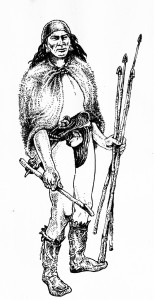First Attempts to Interpret “Bluff-dwellers”
The first researchers to look at bluff shelters created two time periods of bluff shelter use and named cultures to go with them. The older culture or period they called the “Bluff-dwellers” and the more recent they called “Top-layer Culture.” They drew a sharp line between the two. Harrington and Dellinger posited that the Bluff-dwellers were an agricultural society that lived year round in the shelters. They grew corn, hunted with atlatls and made very little pottery. The pottery they did make was grog or grit tempered and undecorated. The implication of this was that the earlier Bluff-dweller culture evolved in place and retained an isolated and separate lifeway from other larger cultural trends in the region. It was thought to have been the longer of the two time periods. According to Harrington, the Top-layer Culture happened much later and was very brief. Harrington thought that the Top-layer culture had moved into the region from elsewhere bringing more advanced technology such as bows and arrows and shell tempered pottery with them.
Beyond Bluff-dwellers

The problem with all of this is that in the 1920s and 30s the basic chronology of southeastern prehistory was still being written. Harrington and Dellinger were looking at a time span much longer than they suspected and labeling it all “Bluff-dweller.” However, because they were working before we understood the cultural timeline of prehistory in the Southeast, they had no idea that they were collapsing 9000 years of time and three major cultural traditions into their single “Bluff-dweller Culture.”
As you can tell from looking at the general timeline, Harrington and Dellinger’s “Bluff-dweller Culture,” with its combination of large dart points, grit-tempered pottery, and agriculture, is actually an odd mix of these different periods. This is because the very complicated bluff shelter strata were being incorrectly interpreted by the early researchers.
This confusion led later researchers to speculate that the technology of the area lagged behind other places in the Southeast because they assumed that the “Bluff-dwellers” used modern agricultural crops like corn at the same time as older hunting technology such as atlatls. The theory was that the mountainous region kept the people who lived there from adopting new technology and lifeways at the same rate as their river valley counterparts. They saw “Bluff-dwellers” essentially as as ancient version of “hillbillies.” Modern techniques such as radiocarbon dating only began to be applied to Ozark bluff shelters in the 1960s. Although we still have a long way to go in figuring out the basic chronology, these modern methods are helping to establish the real timeline of the bluff shelter sites. It now appears that the Ozark region was not isolated in the prehistoric past; it had ties to other cultures in the region and its timeline is analogous to that of its neighbors in terms of the adoption of new technologies.
Further confusing things for Harrington and Dellinger was the fact that people were probably not living in the bluff shelters year round. We now know that there were no “Bluff-dwellers” in the sense of the original concept—that is, prehistoric Native Americans never did “dwell” full time in bluff shelters. Most likely these sites were used by Archaic peoples as one of many short-term living spaces on their seasonal rounds. Because they depended so much on wild foods available in nature, the people did not live in the same place all year, but moved to follow their resources. They probably used bluff shelters as hunting camps or as storage for nuts or other food they collected nearby. Late Woodland and Mississippian period people probably used the shelters in the same way—as seasonal or activity based areas. They also seem to have used certain bluff shelters for ritual purposes—as evidenced by rock art and burials. However, people in these later cultures probably spent the rest of the year in a settled village or hamlet in the bottom lands near the bluff.
This means that archeologists working in Ozark bluff shelters are never seeing the whole picture. The artifact assemblages are not complete in that they don’t represent the whole year in the life of the people who used the shelters. Most likely the older Archaic assemblages are the most complete. This is because semi-nomadic hunters and gatherers generally have few possessions which they have to carry around with them. Later Woodland and Mississippian peoples were more settled and the artifact assemblages in the shelters are likely more fragmented. For example the scarcity of pottery is probably due to the seasonal or periodic use of the sites. The pottery was most likely manufactured and used primarily in other settlement types. To understand this, think of a future archeologist excavating a modern Arkansas deer camp, or a duck hunting club, and interpreting it as representative of the entirety of modern Arkansas life—obviously a mistake! Thus some types of activities (like hunting and storage) are over-emphasized in the bluff shelters, while others are deemphasized (this probably explains the scarceness of pottery). We have to connect what is going on in bluff shelters with what is happening at open habitation sites in the Ozarks if we are to fully understand Ozark prehistory.
In conclusion, the “Bluff-dweller Culture” concept, while a romantic notion, is not very useful to archeologists. It collapses many different time periods and cultures, it over-emphasizes the isolation of the Ozarks, and it does not give us a complete picture of prehistoric life because bluff shelters were special-use sites, not year-round occupations.
On the other hand, bluff shelters are very important to archeologists because their deep, stratified deposits help us to understand the prehistoric timeline. Likewise, the incredible preservation of plant remains and other rare perishable artifacts make bluff shelter sites extremely important in filling gaps in our knowledge of past technologies and the process of plant domestication.